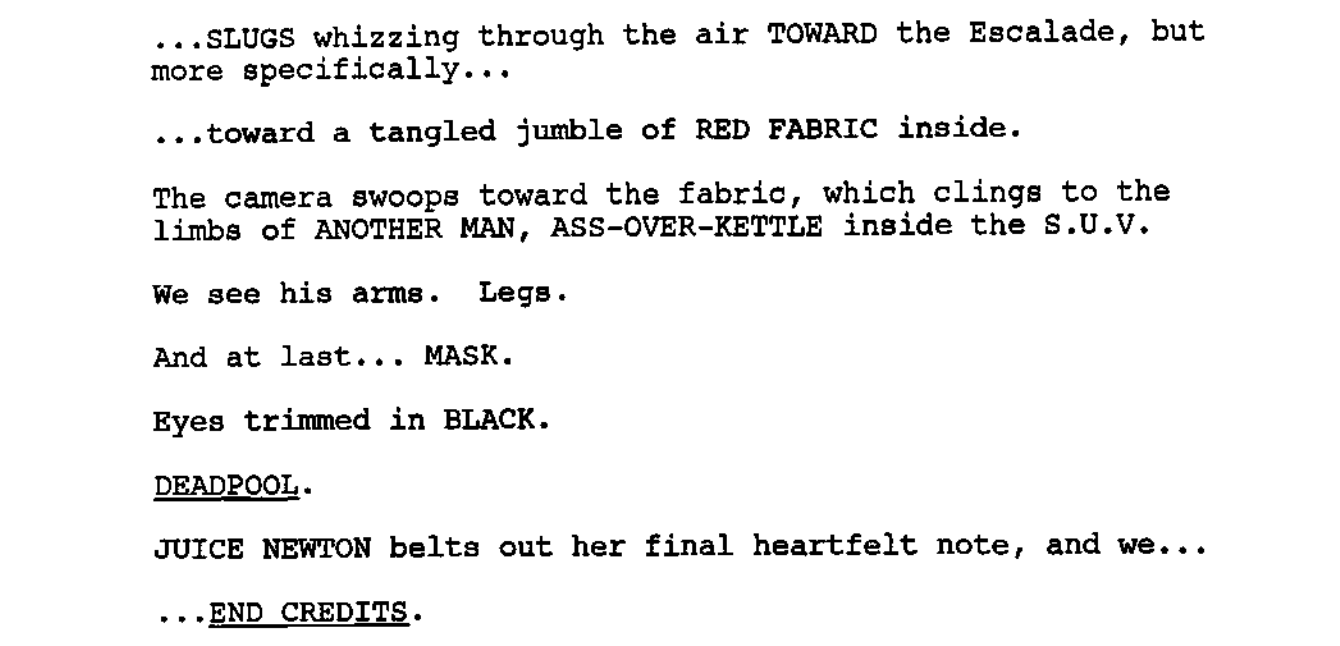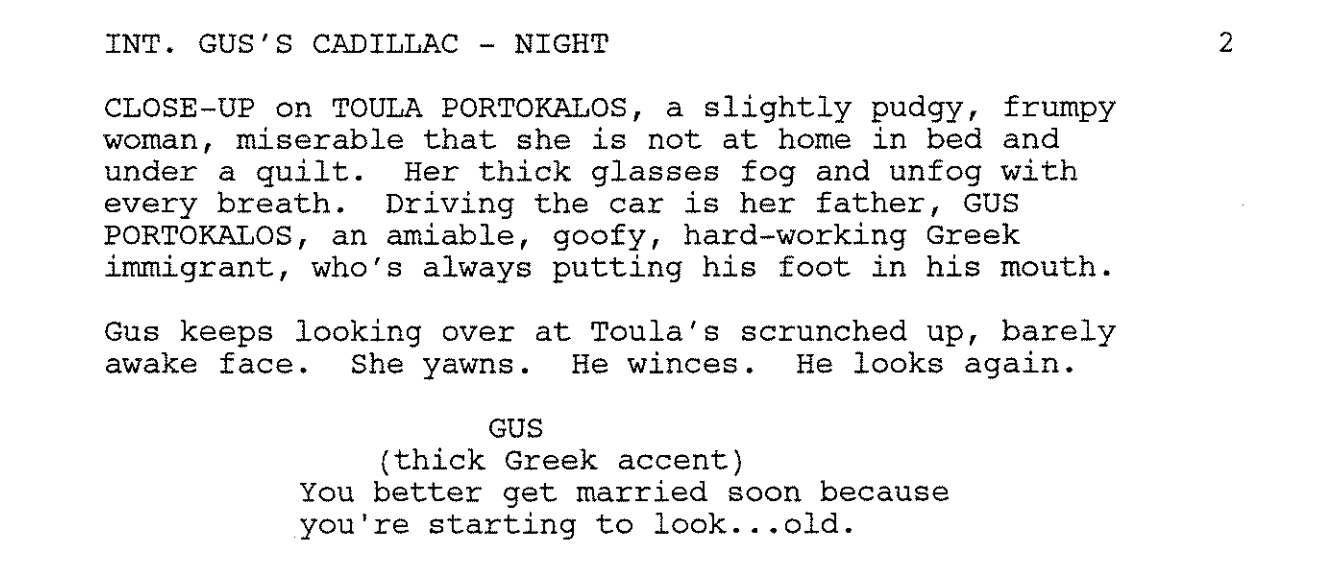WRITING YOUR SCREENPLAY WHILE SOCIAL DISTANCING: CHARACTER DESCRIPTIONS
Welcome to week two of our new blog series focused on structuring, writing and formatting feature screenplays. In this post, we’ll examine a fundamental element of any kind of writing:
Character descriptions.
If the function of characters is to be our emotional tether to a story, it’s vital that a character elicit some kind of emotional response the instant we meet them on the page. With juicy characters, a script can attract talent. The character’s description is the first point of creative lift-off for any number of collaborators on a film. Most importantly, it’s one place to hook a reader early in the story.
Character descriptions pose a unique challenge to screenwriters because the key to effective screenwriting is economy (or packing the biggest emotional punch in as little space and verbiage as possible).
In the library, we’ve noticed that even the most heralded, seasoned writers sometimes fall back on easy, cliched choices in their character description. For reference, see our post from a few years ago about the empty adjectives “beautiful, pretty, attractive, cute,” etc. when describing female characters.
All this to say, it’s a lot of pressure to grab a reader by the throat AND simultaneously avoid harmful descriptive pitfalls. Where does one even begin?
Here we’ll share with you some of our favorite character descriptions and the techniques that make them so effective. We’ve tossed in a few extra spooky ones because ’tis the season!
As always, if you’re looking for help or reference assistance, our e-mail library@wgfoundation.org is always open. While we can’t send PDFs of scripts, we can always advise about formatting as we do here.
Let’s dive right in.
ALMOST FAMOUS (2000)
Written by Cameron Crowe
Cameron Crowe’s scripts are often filled with considerate particulars. This kind of specificity makes the characters authentic and engrossing.
A less thoughtful writer would likely focus on Penny Lane’s beauty as the primary detail of her character. Here it’s her warmth and honest enthusiasm that make her someone who elicits our attention. Her “real interest” is especially powerful when contrasted with condescension and cold-shoulders that William (the protagonist) is met with in the beats prior to this moment.
We care what happens to this girl because in a hostile and uncaring world, she naturally cares.
DEADPOOL (2016)
Written by Rhett Reese & Paul Wernick
This introduction is written in short Walter Hill-like bursts. As we read, we see each shot and each cut with each new line. This tactic draws our attention to each part of Deadpool’s iconic superhero suit.
There’s an anticipatory effect in it as we start to piece Deadpool together with each new line.
The script is also written in a serious, utilitarian style, but using hilarious and subversive adjectives (a la ASS-OVER-KETTLE). It’s fun to read and evocative of who this guy is as a superhero.
HOCUS POCUS (1993)
Screenplay by Mick Garris and Neil Cuthbert
Story by David Kirschner and Mick Garris
In a fantasy film, sometimes it’s important to give a reader a sense of how the characters’ magic, etc. functions within the world of the story (especially if that world is different from our own). These Hocus Pocus descriptions tell us about each witch’s evilness and power.
Note the use of different witch archetypes (or stereotypes?) in these descriptions. There’s the all-powerful, desperate for youth/beauty witch, the Hansel and Gretel-style hungry witch and the unhinged, torturer witch. The writers meld these witch stock characters with comedy stock characters to form a Three Stooges-like sisterhood of funny witches.
The descriptions might seem a little robust for a feature script, but the writers give us all the information we need to understand the rest of the script.
MILLION DOLLAR BABY (2004)
Screenplay by Paul Haggis
Based upon stories from Rope Burns by F. X. Toole
Maggie is a scrappy and spunky fighter. Based on what we’re told about her physical appearance, it seems like she’s taken some hits too, which pulls at our sense of intrigue.
Note how her eyes stay fixed on Frankie. This suggests intent, focus and deliberateness. This tells us that, despite being unkempt and a clear underdog, Maggie is somebody who’s ready to fight for something — and we’re ready to follow her because we see that tenacity.
MOONLIGHT (2016)
Screenplay by Barry Jenkins
Story by Tarell Alvin McCraney
Sometimes it’s not how the character looks and sounds that pulls us in emotionally. Rather, it’s what the character is doing or, in this case, what someone else is doing to them.
Barry Jenkins uses the word “runt” and the idea of hunters chasing prey to garner our immediate empathy for Little.
Introducing the character in a chase immediately stokes our need to see what happens next. We instantly care for this little boy. We want him to evade his tormentors and survive, which is the major overall thrust of the story.
MY BIG FAT GREEK WEDDING (2002)
Screenplay by Nia Vardalos
The word choices here are smart and funny, which tell us we’re in rom-com territory.
This proves that good character description doesn’t have to be relegated to visuals. Description can also exist in what someone says to or about the character.
In one statement from her father, we get a sense of Tula’s personal conflict. There’s a ticking clock present from the get-go. The subtext is: You’d better find somebody to love you before you become completely undesirable. It’s sad and we immediately empathize and are on board to see what happens to her next.
NIGHTMARE BEFORE CHRISTMAS (1994)
Screenplay by Caroline Thompson
Story by Tim Burton and Michael McDowell and Caroline Thompson
At first, we only see Sally from the back. From this angle, she looks totally average. When she turns around, we get a small shock: She’s a Franken-doll with no confidence.
In this short amount of time, we get a sense of what she looks like as well as how she sounds and carries herself — all of which make us care about her. And it’s done with very little text.
This is really just a plug for you to watch our chat with Caroline Thompson where we discuss this very description.
NIGHTCRAWLER (2014)
Written by Dan Gilroy
The eclipses in these lines give us a scattered, stream of consciousness vibe, which completely serves that Lou is described as “pure primal id.” From the get-go, we’re almost in his head.
Likewise, note that before we see the character in person, we see his silhouette or shadow. Oftentimes in literature, the id part of the psyche is represented by shadows or the archetype of “the shadow.”
It’s not coincidental that the first thing we see Lou doing is something illicit. All of these things “id” elements are unified and interconnected.
QUEEN & SLIM (2019)
Screenplay by Lena Waithe
Story by James Frey and Lena Waithe
The use of colons after “The MAN” and “The WOMAN” make this experience like reading character descriptions at the beginning of a published play. It’s fun to see these embedded into the flow of a screenplay.
By describing the characters’ personalities rather than their physical attributes, Lena Waithe ensures their playability by actors.
Combined with everything else, the descriptions evoke a kind of stylistic mood. Just by the character descriptions, we feel like we’re sitting cooly in the same diner.
THE SIXTH SENSE (1999)
Written by M. Night Shyamalan
The technique here is to show us Cole Sear’s patient file before we actually meet him. By feeding us tiny bits of exposition, Shyamalan creates anticipation for meeting the character.
Before we ever even see Cole Sear, we’re interested in him and he engages our empathy because we know he’s isolated, suffering and experiencing difficulties.
No matter what the character is like when he first comes into the scene and starts doing things, we’ll have these nuggets of information in the back of our heads.
SUNSET BOULEVARD (1950)
Written by Charles Brackett & Billy Wilder and D. M. Marshman, Jr.
The huge emphasis on Norma Desmond’s glamorous appearance comes after an equally detailed description of the decay of her Hollywood mansion.
What kind of woman dresses like she’s going to an Oscars luncheon in the middle of her dark and dilapidated home? There’s intrigue in these details.
“High voltage” is not a word used to describe humans, but suggests a frightening Frankenstein-like deathy tirelessness, planting disturbing seeds for what’s to come.
VAMPIRE IN BROOKLYN (1995)
Screenplay by Charles Murphy and Michael Lucker & Chris Parker
Story by Eddie Murphy & Vernon Lynch Jr and Charles Murphy
Why try to analyze or dissect a perfect description? We’re not fucking with it.
Until next time — happy writing!












